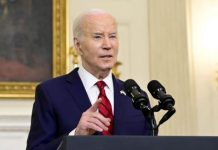https://www.facebook.com/corybooker/videos/10156979723652228/
Aug. 5 (UPI) — New Jersey Sen. Cory Booker announced this week he’d introduced a bill to legalize marijuana nationwide — a measure that usually might not get much attention. However, he used Facebook Live — and immediately reached more than 120,000 people.
Booker’s live announcement is one example of how ever-evolving social pioneering continues to open doors to Washington, D.C., for average Americans.
“Senator Booker believes that Facebook Live is an effective tool to talk directly with his constituents about important policy initiatives,” said spokeswoman Kristin Lynch. “He uses Facebook Live to facilitate the democratic process in the digital age and to address individuals’ questions and concerns in real time.”
Although Booker’s marked the first Facebook Live Senate bill introduction, it wasn’t the first time a member of Congress had used such a platform — which also includes Snapchat and Periscope — to communicate directly and instantly with constituents.
“People react more strongly to video than they do to words,” said Daniel Schuman, policy director at Demand Progress, a group that advocates government transparency. “Having it be live, people can react in real time.”
Booker joined Rep. John Lewis, D-Ga., in June when he live-streamed thoughts about Republican efforts to dismantle the Affordable Care Act — while the Senate debated a bill that would have repealed and replaced it with a GOP version that would’ve left 22 million Americans without health care.
With over 1 million views and 13,000 shares on the live stream, the two politicians spent hours explaining the Republican bill’s flaws, as well as their opinions on what’s needed to ensure Americans’ access to health care.
“Senator Booker is always looking for new and creative ways to connect with constituents,” Lynch said. “I wouldn’t say one form of social media is necessarily better than another. Different platforms offer different advantages.”
“It allows people outside of government to have an interest in what’s going on and be able to engage better with what’s happening,” Schuman added.
“It is a must that people be informed,” Lewis said during the beginning of the nearly four-hour live stream. “That people know what is happening here. What is about to happen to … more than 20 million of our citizens.”
As hundreds gathered for the impromptu rally, Senate Minority Leader Chuck Schumer and Democratic Sens. Dick Durbin of Illinois, Chris Murphy of Connecticut, Brian Schatz of Hawaii, Kirsten Gillibrand, of New York, Bob Casey of Pennsylvania and Jeff Merkley of Oregon joined Booker and Lewis on the stairs.
“Having your own stream with your own setup lets you have your own frame for your event, as well as a full record of what happened,” said Brian Selander, former communications director for Delaware Sen. Tom Carper, who now makes media and tech investments at venture firm SeventySix Capital.
The June live stream from the Capitol steps wasn’t the first use of live social videos around important Hill events. Utah Sen. Mike Lee used Facebook Live in October to ask then-candidate Donald Trump to leave the race after his comments about women.
“I certainly don’t think I would feel comfortable hiring that person to be the leader of the free world,” he said at the time.
In February, Sen. Elizabeth Warren, D-Mass., stepped outside the Senate chamber during a debate on the nomination of now-Attorney General Jeff Sessions. Senate Majority Leader Mitch McConnell had blocked her from reading a letter from Coretta Scott King, the widow of Martin Luther King, Jr., in opposing Sessions’ appointment to a federal judgeship in 1986 — a position he did not get.
Instead, Warren used a live stream to read King’s letter. It attracted more than 12 million views and 222,000 shares.
Rep. Sheila Jackson Lee, D-Texas, has turned to streaming platforms “to connect more directly” with constituents — “essentially bringing them with her in her daily endeavors with the hopes of shedding light on the intricacies associated with the democratic process,” spokesman Remmington Belford said. “She also uses this to help sustain a connection with her millennial constituents.”
Jackson Lee later used Facebook Live to criticize Trump for a tweet about television host Mika Brzezinski. It gained over 63,000 views.
The first notable congressional live stream came in 2016, when Democratic congressmen staged a 26-hour sit-in in the House over gun control. Normally, the event would’ve been broadcast by C-SPAN, but House Republicans adjourned the session and the cameras were turned off. That’s when Democrats turned to live streaming to get their message out.
However, not all members of Congress are big live-streamers — yet.
Rep. Bennie Thompson, D-Miss., has his first planned for next week — to showcase a corporation’s gift that will help constituents in Mississippi in need.
“This will be our first time using Facebook Live, and we are excited about it,” said Guy King, Thompson’s press secretary. “It provides transparency, which is the most important thing for anyone in elected office.
“As we move forward in the future, our office will definitely be utilizing more of Facebook Live.”





